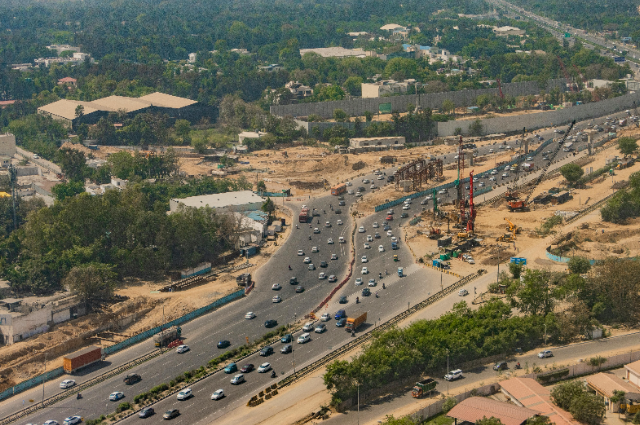
You can feel it everywhere. India is changing so fast, sometimes you pause and wonder if it’s even the same country. You look out, there are cranes blocking half the skyline, roads popping up in places that used to be dirt tracks, chai vendors taking QR payments like it’s no big deal. It’s wild, stuff you couldn’t even imagine a few years ago is now just… life. But it’s not just the big numbers from government speeches. These changes hit you in small moments, buying groceries, commuting, meeting people who now work for startups instead of old family businesses. Sometimes it feels like everyone’s sprinting, trying not to fall behind. But maybe this is what real growth actually looks like: messy, noisy, kinda emotional, and honestly, exciting.
The Economy Refuses to Slow Down
Everywhere you turn, there’s buzz. India’s economy is going absolutely nuts7.8% GDP growth for the April-June quarter this year, the best jump we’ve seen in ages. Throw in the full-year forecast at around 6.5%, and you see why analysts keep hyping up India as the next big thing. It’s crazy to think we might be the world’s fourth-largest economy next year.
But, on the ground, it’s not about numbers. It’s that energy, people building things, launching side hustles, pitching ideas instead of just hunting jobs. There’s something different here compared to the safe, slow-paced India our parents grew up in. Now it’s like, “Let’s just go for it.”
Roads, Rails, and Real Dreams
It’s not just mega-cities anymore. You see development everywhere. Highways cut through small towns, new trains actually connect districts, and IT parks, like the one in Kadapa, are showing up in places nobody would’ve considered “big time” before. These changes open up actual dreams.
Just a few years ago, the idea of freelancers working out of Kadapa or QR codes at chai stalls would’ve sounded nuts. Now it’s normal. Growth isn’t just some fancy word; it’s hope, spreading in ways people can really feel.
Riding the Digital Wave
India’s digital scene honestly feels like magic sometimes. We’re done just being tech consumers; now we’re making stuff. College kids launching startups from their bedrooms, grandmas paying bills on UPI, tiny businesses showing up online. Tech giants are dropping billions here, bringing in more than 80,000 advanced GPUs for a huge digital infrastructure push this year.
AI hubs are popping up not only in big cities, but even in smaller towns. Now, the kids from remote villages get online lessons, content creators cash in doing what they love, and tiny shops suddenly have customers all over. Sometimes, yeah, it’s too much and a bit overwhelming. But it’s opening doors for millions who never had a shot before.
The System Trying to Keep Up
You can almost see the system scrambling. New startup rules, better loans for small businesses, city upgrades left and right, metros, flyovers, and sanitation fixes. There is still loads of red tape, but for once, you see effort and people actually notice it. Urban reforms aren’t just talk; there’s a $10 billion plan rolling out to make cities livable, clean, and a bit less stressful over the next five years. Is it perfect? No way. But for the first time, people really believe things might, just maybe, get better.
Growth That’s Finally Going Beyond Big Cities
This is the bit that feels revolutionary. The opportunities aren’t just in Delhi or Mumbai anymore. Tier-2 and tier-3 cities are getting their turn. Malls, colleges, tech parks, even Kadapa, these places aren’t just a side note now; they’re full-on hubs. It means people can stay closer to family, live without going broke, and still chase those big dreams. That’s not just progress, it’s a whole new version of hope, and a much more balanced, inclusive India starting to show up.
The Complicated Side of Growth
No change is flawless. Fast progress brings tough stuff to face; there’s still a gap between those moving fast and those stuck just trying to get by. Inflation bites, the climate can be brutal, and not everyone gets the same slice of the pie. Sometimes it’s hard to see high-rises standing right next to makeshift tents. Progress should mean quality of life and dignity, not just some shiny GDP number.
We’re not there yet. But it at least feels like everyone’s actually trying.
Our Generation Is Living the Switch
We’re the ones living through this crazy jump, from old-school India with coins and paper, to the digital everything India. We’ve watched slow trains turn into expressways, seen our tiny towns get their place in the national buzz. It’s overwhelming some days, exciting others, but it always feels like something’s happening. We aren’t just watching from the sidelines; we’re in it, hustling, building, and dreaming about futures our parents couldn’t even picture.
Looking Forward, No Rose-Colored Glasses
India’s story is nowhere near perfect. There are glitches, setbacks, and moments that suck. But every reform, every new road, every fresh business, every time a student gets a digital job, it’s all proof of a messy, totally real heartbeat. Progress happens when a chai shop starts taking UPI, when a tiny town opens its own tech park, or when a freelancer lands that first online client. It’s these ordinary moments that change lives. India is moving ahead, sometimes too fast, sometimes in cool directions, sometimes making mistakes. And honestly, the messy, emotional, imperfect version is the one we believe in. It’s real, it’s ours, and it’s not slowing down.
References
- Deloitte (2025). India's economic outlook, October 2025. https://www.deloitte.com
- Trading Economics (2025). Full Year GDP Growth in India. https://tradingeconomics.com
- Forbes (2025). India is Withstanding Tariffs To Remain the World’s Fastest-Growing Major Economy. https://www.forbes.com
- Money Control (2025). STPI bets on tier-2, tier-3 cities to build India's next wave of tech entrepreneurs. https://www.moneycontrol.com
- Intro (2025). India GPU Infrastructure Landscape: A Comprehensive Survey. https://introl.com
